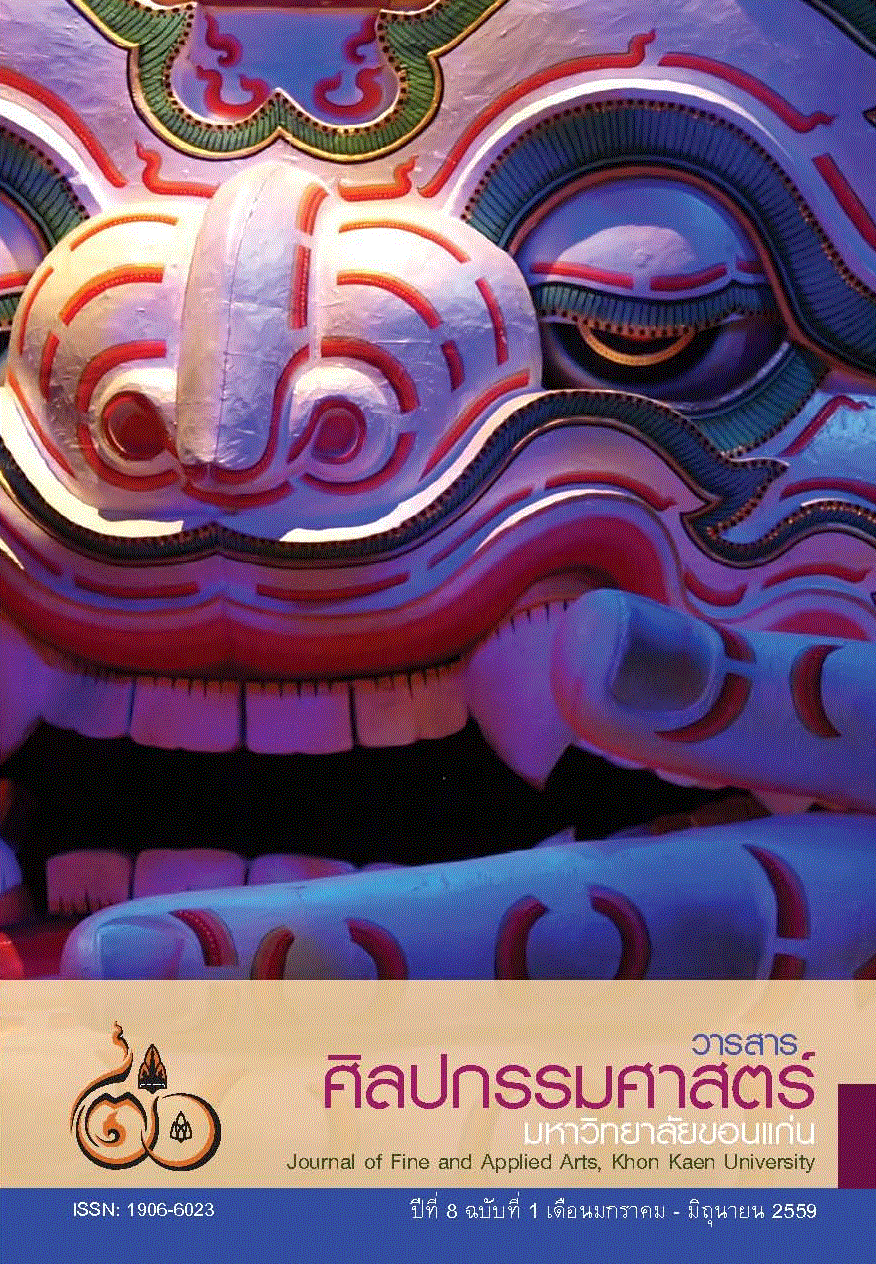การศึกษาสังคีตลักษณ และแนวคิดการดนกีตาร ในเพลงแจส ของเวส มอนทโกเมอรี่
Main Article Content
Abstract
การวิจัยครั้งนี้มีวัตถุประสงคเพื่อศึกษา 1) เพื่อศึกษาสังคีตลักษณในเพลง แจสของเวส มอนทโกเมอรี่ 2) เพื่อศึกษาแนวคิดที่ใชในการการดนกีตารในเพลงแจส ของเวส มอนทโกเมอรี่จากบทเพลงที่ประพันธและบรรเลงโดย เวส มอนทโกเมอรี่ 8 เพลง ไดแก 1) Mi Cosa 2) Sundown 3) Cariba 4) Fried Pies 5) Four on Six 6) Missile Blues 7) O.G.D. 8) West Coast Blues จากการวิเคราะหสังคีตลักษณในบทเพลงดังกลาวพบวาทั้ง 8 บทเพลงใช สังคีตลักษณแบบ ทํานองหลักและการแปร (Theme and variation) ในสวนของทํานองหลัก พบวาไดมีการสรางและพัฒนาทํานองหลักโดยใชวิธีการ พัฒนาที่หลากหลายไดแก การสรางและพัฒนาทํานองหลัก ดวยการซํ้า (Repetition) การใชวิธีการพัฒนาทํานองดวยการปรับระดับเสียง (Transposition) การสอดแทรก แนวความคิดใหม (New Idea) เพิ่มเติมสลับกับทํานองหลักการขยายทํานองดวย การซีเควนซ (Sequence) การสรางประโยคเพลงในลักษณะ ถาม – ตอบ (Call and Response) การพัฒนาโมทีฟดวยการตัดโนตในโมทีฟหลักบางตัวออก (Motif Omission) การดัดแปลงกระสวนจังหวะของโมทีฟ (Motif Transformation) การ ขยายแนวคิดโดยการสรางทํานองใหมเพื่อสรางความแตกตาง (Contrast) เปนตน การประสานโดยสวนใหญเปนระบบประสานเสียงแบบ โทนาลิตี มีเพียงทอน A ในเพลง Micosa ที่มีการประสานเสียงแบบ แพนไดอาโทนิค (Pandiatonic) ในการ ดําเนินคอรดพบการดําเนินคอรดแบบ “เวส โคสท เชนจ” (Wes Coast Changes) ซึ่งคิดคนและเปนเอกลักษณในการดําเนินคอรดของ เวส มอนทโกเมอรี่ สวนของการแปรทํานอง พบการแปรทํานองโดยการบรรเลงดวยวิธีดน เรียก การแปรแตละครั้งวา “คอรัส” (Chorus) ซึ่ง 1 คอรัส หมายถึงการแปร 1 ชุด พบ วาในแตละเพลงมีรูปแบบของการบรรเลงในแตละคอรัส คือสวนแรกเปนการบรรเลง ดวยการดนแบบโนตแนวเดียว (Single Notes) สวนที่สองคือการเลนแบบขั้นคู (Octave) สวนที่สามคือการเลนแบบคอรดโซโลหรือ บล็อกคอรด (Block Chords) ในการวิเคราะหการดนกีตาร พบวามีแนวคิดวิธีการดนหลักจากการ ใชการพัฒนาโมทีฟ ในลักษณะตาง ๆ โดยยึดโครงสรางของเสียงประสานควบคูไปกับการสราง แนวทํานองและจากการใช โหมด สเกล, อารเปโจ, การเคลื่อนของแนวทํานองที่แบบ โครมาติค, เอ็นโคลสเซอร, สรางแนวทํานองซอนทับลงไปบนคอรด, การเกลา 7-3, การใชโนตนอกกุญแจเสียง เปนหลัก
This research aims to analyze forms of Wes Montgomery’s music and to study his improvisation concepts in these 8 songs which are 1) Mi Cosa 2) Sundown 3) Cariba 4) Fried Pies 5) Four on Six 6) Missile Blues 7) O.G.D. 8) West Coast Blues The research results show that Theme and Variation form was used in all eight songs. There were various techniques which were employed in creating and developing themes which were repetition, transposition, addition of new ideas alternating with the motif, motif extension by using sequence, creation of call and response, omission of motif, transformation of motif and creation of contrast motif. All eight songs were tonal music. However, there was only section A in Mi cosa which was played in Pandiatonic. Wes Coast Changes chord progression was used. This chord progression was created by Wes Montgomery and became his unique style. Wes Montgomery varied his melody by improvising and called each variation “Chorus” (one chorus means one variation). The fi rst section was improvised with single notes. The second section was improvised using an Octave. The third section was played using chords solo and block chords. From guitar improvising analysis, it shows that Wes Montgomery majorly employed motivic development which kept the harmonic structure along with creating new motif. Moreover, in order to create his improvisation, he used mode, scale, arpeggio, chromatic movement, enclosure, superimpose, 7-3 resolution and outside playing.
Article Details
Content and information in articles published in the Journal of Fine and Applied Arts of Khon Kaen University is regarded as the opinion and sole responsibility of the author(s) directly; therefore, editors are not obliged to agree to or share any responsibility with regard to the content and information that appears within these articles.
All articles, information, content, image, etc. that have been published in the Journal of Fine and Applied Arts of Khon Kaen University is the copyright of the Journal of Fine and Appllied Arts of Khon Kaen University. Any person or organization who wishes to distribute all or parts of the articles for further dissemination or other usage must first receive permission from the Journal of Fine and Applied Arts of Khon Kaen University before proceeding to do so.


